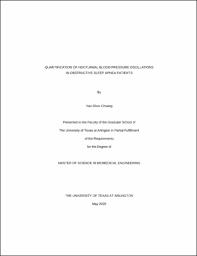| dc.description.abstract | An approach to quantifying and analysis of nocturnal blood pressure (BP) variations that are elicited by sleep-disordered breathing (SDB) is presented. A sample-by-sample aggregation of the dynamic BP variations during normal breathing and BP oscillations prompted by apnea episodes is performed. This approach facilitates the visualization and analysis of BP oscillations. Nocturnal BP oscillations reflect the cardiovascular stresses that SDB mediates and may be of clinical significance. Preliminary results from an analysis of full night study of 10 SDB subjects (8 Male 2 Female, 53±5.7 yrs., Body Mass Index 34.5±7.8 kg/m2, Apnea-Hypopnea Index 63.5±28.7) are presented. Aggregate trajectory and quantitative values for changes concomitant with obstructive apnea episodes are presented for systolic blood pressure (SBP), diastolic blood pressure (DBP), mean arterial blood pressure (MAP) and pulse pressure (PP).
Further, the effect of sleep stages is considered. The results show 17.6 mmHg (13.7%) surge in SBP and 9.5 mmHg (13.7%) surge in DBP. By computing the MAP and PP, an 11.8 mmHg (13.3%) and a 9.8 mmHg (16.4%) surge in MAP and PP, respectively, were observed. When compared to their respective values during normal breathing, SBP, DBP, and PP show significantly different mean values (p<0.001). Additionally, the peak of the surge in SBP, DBP, and MAP occurred about 7s post the end of apnea events. This delay is around 8s for PP. Further, the rate of surge in SBP and DBP due to apnea was estimated by computing the slopes of their rise. They were0.9 mmHg/s and 0.6 mmHg/s, respectively. . When computing the surge rate of SBP in various sleep stages, the slopes were approximately 0.95 mmHg/s, 0.93 mmHg/s, 0.89 mmHg/s and 0.7 mmHg/s for of Stages 1, 2, 3, and REM, respectively. Similar analysis for DBP showed the slopes to be approximately 0.64 mmHg/s, 0.69 mmHg/s, 0.53 mmHg/s and0.39 mmHg/s for Stages 1, 2, 3, and REM, respectively. The results of this study provide means of quantifying both the rate and the level of nocturnal blood pressure oscillations. | |


